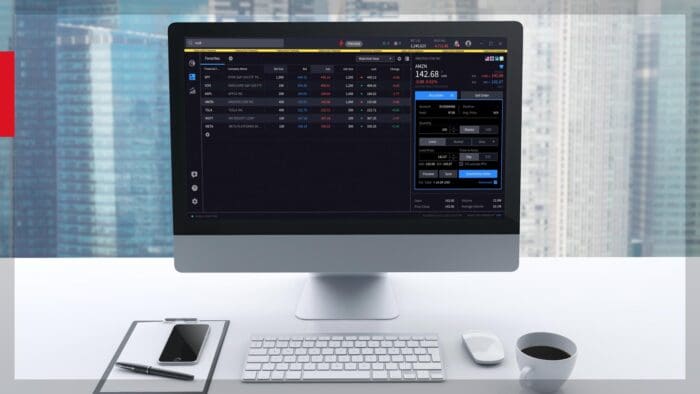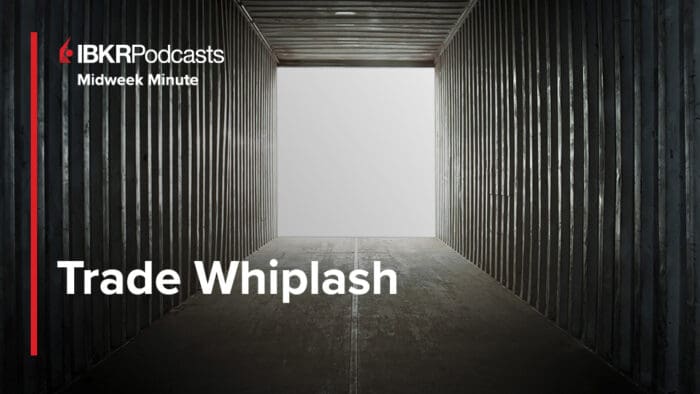Market Chameleon’s Dmitry Pargamanik & Will McBride join IBKR’s Jeff Praissman for an in depth look at Open Interest and how it can be used by traders and investors when analyzing options.
Summary – IBKR Podcasts Ep. 234
The following is a summary of a live audio recording and may contain errors in spelling or grammar. Although IBKR has edited for clarity no material changes have been made.
Jeff Praissman
Hi, everyone. My name is Jeff Praissman with Interactive Brokers, and we’re here at the podcast studio with Market Chameleons, Demetri Pargamanik and Will McBride. Hey, guys, how are you?
Dmitry Pargamanik
Hey.
Will McBride
Thanks for having us.
Jeff Praissman
Always my pleasure—love having you guys swing by for our monthly podcast. You just put on a great webinar on option open interest, and I’m excited to have you in the studio so we can continue the discussion for our listeners.
So I want to start off with the basics, right? We’re going to talk about open interest—what exactly is options open interest?
Dmitry Pargamanik
Yeah, options open interest is something that is calculated by the Options Clearing Corporation. What it does is different from volume—it shows us the options that are still open, meaning there are positions out there that have yet to close out, get exercised, or expire.
So these are open positions that exist right now in the market.
Jeff Praissman
I think that’s a good point. I think people may sometimes confuse open interest with volume. So how exactly is open interest calculated? Is it something that’s done in real time, or how often is it calculated?
Dmitry Pargamanik
We get that question a lot—whether you can see open interest in real time. But the way open interest is calculated is that it’s actually done overnight by the Options Clearing Corporation based on end-of-day settled trades. It also takes into consideration any type of corporate actions, exercises, or expirations.
So it’s not something we can see in real time. It doesn’t get reported like a trade does in real time by the options exchange. When you see a trade, it gets executed and then reported to the OPRA feed—the Options Price Reporting Authority. However, open interest is a little different.
That’s handled by the OCC, which goes through a reconciliation process overnight, and then they make the new open interest available the following day.
Jeff Praissman
And just to further clarify for the listeners—essentially, if a thousand option contracts trade and both sides are opening, then open interest would increase by a thousand. But if a million contracts trade—this is obviously an extreme example—and one side was opening while the other was closing, the open interest would stay the exact same, correct?
Dmitry Pargamanik
Yeah. There are a lot of scenarios where people get confused because they try to compare volume with the change in open interest. But because of the way they’re calculated, you’re exactly right—we could have a lot of volume with no change in open interest, or we could have a lot of volume and then see open interest go down to zero because positions are closing or getting exercised at the end of the day.
Or, you could have volume that is much higher than the change in open interest. For example, let’s say in the morning, two sides are opening, and later, in the same option, one side is closing while a different party is opening. The volume will go up, but let’s say this happens with 10 contracts—two trades of 10 contracts each.
The open interest would only go up by 10 because the second transaction was just someone transferring their position to a different party, not necessarily opening a new position.
So it’s very important to understand how that works, especially when analyzing volume and the subsequent change in open interest.
Jeff Praissman
That kind of leads me to my next question—why is open interest important? In that example, a million contracts could trade, and the open interest stays the same. That’s an extreme case, but why is open interest important?
Dmitry Pargamanik
Open interest tells us how much of the previous day’s volume converted to new positions—new risk. Did new positions increase? Did they decrease based on the previous day’s volume?
We could have a lot of volume, but if the open interest really stayed the same, then there’s no real increase in that particular option. That’s the insight you get from open interest.
Jeff Praissman
Is there a maximum limit to open interest?
Dmitry Pargamanik
Yeah, there is. Every security has a different limit, but a limit is established because options are a derivative. You need to have a certain amount of stock available to create options, right? You can’t create unlimited options on a limited supply of stock.
So there is a cap on how many options contracts can be open on a particular security. It makes sense—if there were only 100,000 shares of stock outstanding, you wouldn’t be able to create options on a million shares of stock. So there’s definitely an established limit on open interest.
Jeff Praissman
And, with all the great conversations the three of us have, it always comes down to: how do we utilize whatever subject we’re talking about?
Since we’re always talking about options, how is this information or data used by investors and traders? What are some ways open interest is used?
Dmitry Pargamanik
There’s really no single way—investors use it differently, mainly to gain insights into the markets.
One way is to assess the liquidity of an option. When looking at a particular option, you want to determine how liquid it is—how much trading activity and how many positions are being carried. One way to do that is by looking at open interest.
If an option has zero open interest, there are no open positions, and maybe that option is less liquid. Price discovery might also be more uncertain. But if there’s a lot of open interest, it could indicate that the option is more liquid, with better price discovery and a clearer sense of fair value.
So that’s one way open interest provides insight—just by observing it.
Jeff Praissman
Can investors and traders also use open interest to gauge market sentiment?
Dmitry Pargamanik
One way to try to assess market sentiment is to compare open interest relative to its history. If open interest is climbing or relatively high, then there’s more activity or interest in the stock than usual—more betting, more risk-taking in a particular security.
Sometimes, we’ll see that around events, which could explain why open interest is increasing. For example, around earnings, you’ll typically see an uptick in volume and an increase in open interest. But there could be other reasons as well, and that can be a way to measure trader sentiment around a stock.
Jeff Praissman
Are investors able to use open interest as an indicator for support and resistance?
Dmitry Pargamanik
You may be able to use it as a reference point. The thing with open interest and options is that you have different strikes available. Unlike futures, where you have a single price level, with options, you have at-the-money strikes, out-of-the-money strikes, and further out wings and tails.
By observing where there’s a concentration of open interest and at which strikes, it may help assess where traders are targeting—what range of strikes they are focusing on. If there’s large outstanding open interest on a particular strike, that could certainly influence trading activity because it creates hedging needs.
When there’s a significant position at a strike, traders may need to rebalance their risk, which can create more trading activity around certain inflection points.
And, as in all our conversations, it comes back to analyzing data—how it can be used in the real world for trading strategies. What are some ways traders and investors can utilize open interest for trading strategies?
Open interest itself is not a strategy in the way that, say, a call spread is a trading strategy. You can buy and sell, but open interest is more about the information surrounding an option. However, that information can be very useful.
For example, professionals like market makers use it frequently. You’re aware of strategies like capturing dividends on the ex-date, or early exercising deep in-the-money American-style options like puts. At a certain point, it makes sense to exercise early, but if a trader is inefficient and doesn’t exercise, others may exploit that by finding open interest and executing a carry trade in deep in-the-money options.
Another example is pin risk at expiration. If there’s a lot of open interest on a strike towards the end of the day, traders may anticipate potential order flow and adjust accordingly.
If you see very high open interest before an earnings event and then earnings are announced, you can infer from historical patterns that order flow will likely start to unwind as traders take risk off. Open interest can help anticipate or infer how much order flow may need to exit once the event is over—typically, there’s a “risk-off” move post-event.
These are some of the ways people look at open interest to gauge what others are doing—where they’re targeting, whether they’re in short-dated or longer-dated options, whether they’re focused on calls or puts.
Open interest itself also needs deeper analysis. You need to go back and examine what type of trading caused the increase in open interest.
For example, an increase in open interest could be due to simple buying and selling of an option. But it could also be from a large spread trade, where someone is buying one option and selling another as part of a strategy. That tells you something different—it wasn’t just speculation on a single option but rather part of a structured trade.
So it’s important to investigate: How did we get to this point? Was it a single big trade? Was it part of a broader strategy? These details matter.
Jeff Praissman
Pretty much, like with most things we talk about, open interest is just another tool in the toolbox.
You have to look at multiple data points and extrapolate intelligent relationships between them to get a clear picture. You can’t just look at open interest. You can’t just look at volume. You can’t just look at volatility. You can’t just look at spreads or lack of spreads.
You have to take everything into account—the who, the how, the what, the why—right?
Dmitry Pargamanik
Yeah. To answer more questions and become more informed.
Jeff Praissman
And again, just to emphasize for our listeners, especially those newer to the options market: open interest and volume are very different things.
The absolute volume of trading is a very different data point from open interest. They are related, of course, but they’re not the same—it’s not apples to apples.
Dmitry Pargamanik
Exactly. You need to understand the differences, because if you don’t, you won’t get the right insight from open interest.
Like I said, a lot of people assume open interest is calculated in real time or that it directly correlates to volume. But it doesn’t—volume does not translate into a direct one-to-one correlation with open interest.
Jeff Praissman
Are there any final thoughts you’d like to leave our listeners with regarding open interest or anything trading- or options-related?
Dmitry Pargamanik
For investors interested in trading, risk assessment, and getting deeper insights into the options market, I’d encourage them to learn about open interest. Understand what it means, what it can indicate, and analyze it even from a historical perspective.
For example, ask: Are we at a relatively high level of open interest? Are we at a low level? What does that mean?
And once you identify those levels, check implied volatility and other factors to paint a clearer picture of the market you’re trading.
Jeff Praissman
This is great. Dmitry, Will—thank you.
Again, I’d like to remind everyone that we do a monthly podcast with Market Chameleon. We also host a monthly webinar, and Dmitry and Will were kind enough to stop by afterward to do a deeper dive into this subject.
If you missed the webinar, you can visit our website, go to the education section, click on webinars, and find previously aired sessions. You can also go to the contributors section, click on Market Chameleon, and access all the great podcasts and webinars we’ve done together.
And just a reminder—the podcasts are available on Spotify, Amazon Music, and all the usual platforms, as well as our website.
Dmitry and Will also do a great YouTube show every trading day morning at 9 a.m., right before the market opens.
Right, guys?
Will McBride
Yep. 9 a.m.
Jeff Praissman
Great. Thanks, guys—I appreciate it.
Join The Conversation
For specific platform feedback and suggestions, please submit it directly to our team using these instructions.
If you have an account-specific question or concern, please reach out to Client Services.
We encourage you to look through our FAQs before posting. Your question may already be covered!
Leave a Reply
Disclosure: Interactive Brokers
The analysis in this material is provided for information only and is not and should not be construed as an offer to sell or the solicitation of an offer to buy any security. To the extent that this material discusses general market activity, industry or sector trends or other broad-based economic or political conditions, it should not be construed as research or investment advice. To the extent that it includes references to specific securities, commodities, currencies, or other instruments, those references do not constitute a recommendation by IBKR to buy, sell or hold such investments. This material does not and is not intended to take into account the particular financial conditions, investment objectives or requirements of individual customers. Before acting on this material, you should consider whether it is suitable for your particular circumstances and, as necessary, seek professional advice.
The views and opinions expressed herein are those of the author and do not necessarily reflect the views of Interactive Brokers, its affiliates, or its employees.
Disclosure: Market Chameleon
The information provided on MarketChameleon is for educational and informational purposes only. It should not be considered as financial or investment advice. Trading and investing in financial markets involve risks, and individuals should carefully consider their own financial situation and consult with a professional advisor before making any investment decisions. MarketChameleon does not guarantee the accuracy, completeness, or reliability of the information provided, and users acknowledge that any reliance on such information is at their own risk. MarketChameleon is not responsible for any losses or damages resulting from the use of the platform or the information provided therein. The 7-day free trial is offered for evaluation purposes only, and users are under no obligation to continue using the service after the trial period.
Disclosure: Options Trading
Options involve risk and are not suitable for all investors. For information on the uses and risks of options, you can obtain a copy of the Options Clearing Corporation risk disclosure document titled Characteristics and Risks of Standardized Options by going to the following link ibkr.com/occ. Multiple leg strategies, including spreads, will incur multiple transaction costs.


















it would be good, if you could take a specific example for a particular stock and how traders could use in their trade using open interest. Anyway useful information
Hello, we appreciate your kind words and have passed your feedback to the appropriate team. We hope you continue to enjoy Traders’ Insight!
Good
So, does ibkr allow you to see historical oi data or gives the change from the previous trading sessions?
Hello, thank you for asking. The best place to find historical data is in Trader Workstation via a chart or the Time & Sales tool. In TWS, right-click on the stock you wish to get historical data for. To bring up a chart, select Charts from the right-click menu followed by New Chart. To bring up the Time & Sales tool, select Analytical Tools from the right-click menu followed by Time & Sales. Please review this FAQ for more information: https://www.interactivebrokers.com/faq?id=40339120
We hope this helps!